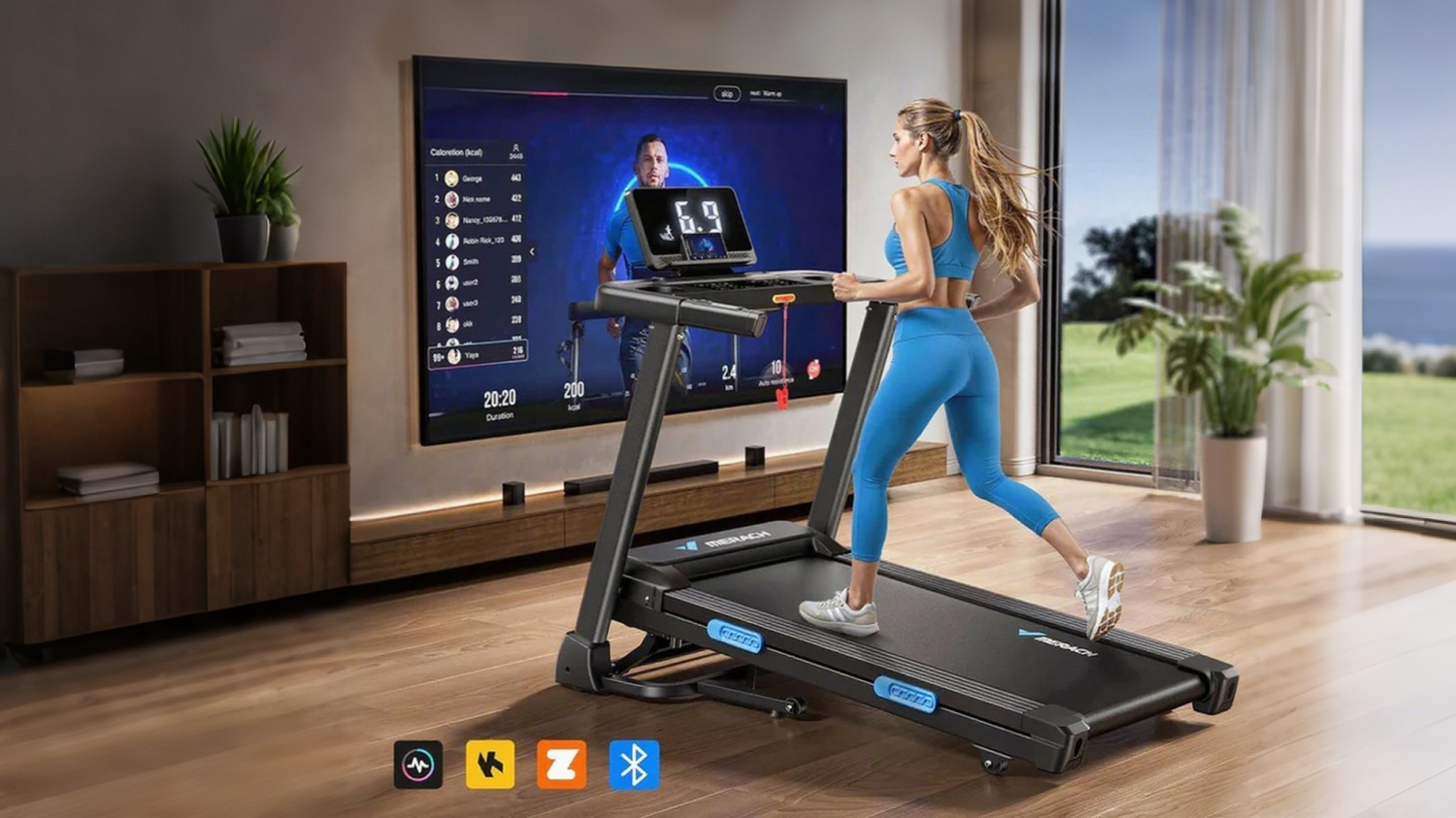Treadmill interval workouts combine convenience with effectiveness, making them a go-to option for busy fitness enthusiasts. But there's a significant difference between mindlessly jumping on a treadmill for a few sprint intervals and strategically designing your workout for maximum results.
After researching the latest exercise science and consulting with fitness professionals, I've compiled the 10 most impactful tips for taking your treadmill interval workouts to the next level. These evidence-based strategies will help you burn more calories, improve conditioning faster, and make your treadmill sessions more engaging and effective.
1. Master the Pre-Set Timing Function
One of the biggest advantages of treadmill interval training is precision timing—but many people fail to utilize this feature effectively.
Why It Matters
Manual interval timing leads to inconsistent work periods, extended rest breaks, and significant momentum loss during transitions. When you're constantly looking at your watch or phone, your focus shifts away from performance and proper form.
How to Implement
Learn to pre-program your intervals on your specific treadmill model:
- Most modern treadmills have interval or custom workout functions
- Program both work and recovery periods before starting
- Include your warm-up and cool-down phases in the programming
- Save your custom workouts for quick access in future sessions
For example, you might program:
- 3-minute warm-up at 3.5 mph
- 30-second sprint at 8.0 mph
- 90-second recovery at 3.0 mph
- Repeat sprint/recovery 8 times
- 3-minute cool-down at 3.0 mph declining to 2.0 mph
Pro Tip: If your treadmill lacks advanced programming features, use an interval timer app on your phone with audio cues so you don't need to watch the screen.
2. Leverage Incline for Lower-Impact Intensity
Many runners make the mistake of focusing solely on speed for interval intensity, overlooking the power of incline adjustment.
Why It Matters
Increasing speed dramatically increases impact forces and injury risk, particularly for sprint intervals. Incline, however, can significantly elevate heart rate and calorie burn while reducing joint stress and maintaining proper running mechanics.
Research shows that running at a moderate speed on a 6-8% incline can burn as many calories as sprinting on a flat surface, with significantly lower impact forces.
How to Implement
Try these incline-based interval approaches:
-
Hill Sprints: 30 seconds at 6-10% incline at moderate speed (6-7 mph for most) followed by 60-90 seconds flat recovery
-
Ascending Hills: Start at 4% incline, increase by 1% each interval while maintaining the same speed
-
Mixed-Stimulus Intervals: Alternate between high-speed flat intervals and moderate-speed incline intervals
Pro Tip: When running on an incline, lean slightly forward from the ankles (not the waist), shorten your stride, and focus on pushing off powerfully with your back foot.
3. Design Smart Work-to-Rest Ratios
The relationship between your work intervals and recovery periods dramatically impacts the training effect.
Why It Matters
Many people use arbitrary work-to-rest ratios without considering their fitness level or training goals. This results in either incomplete recovery (diminishing performance on subsequent intervals) or excessive rest (reducing overall workout intensity).
How to Implement
Match your work-to-rest ratio to your specific goals:
-
For anaerobic power development: 1:3 or 1:4 ratio (e.g., 15-second sprint, 60-second recovery)
-
For improved lactate threshold: 1:1 or 1:2 ratio (e.g., 60-second hard effort, 60-second recovery)
-
For endurance and fat loss: 1:1 or 2:1 ratio (e.g., 2-minute moderate-high effort, 1-minute recovery)
As your fitness improves, gradually reduce rest periods rather than dramatically increasing work intervals.
Pro Tip: For true high-intensity intervals, rest periods should allow heart rate to recover to about 60-65% of your maximum before starting the next work interval.
4. Incorporate Dynamic Deceleration
One of the biggest momentum-killers in treadmill intervals is the transition between high and low speeds.
Why It Matters
Abruptly hitting the stop button or jumping to the side rails between intervals breaks your rhythm, wastes time, and creates safety risks. Additionally, the gradual slowdown of most treadmills means you're often still at high speed when your rest period should be starting.
How to Implement
Master the art of dynamic deceleration:
-
As your work interval ends, grasp the handrails lightly for stability
-
Gradually shift your body backward on the treadmill belt (not jumping off)
-
As the belt continues at high speed, your effective speed decreases
-
Simultaneously start reducing the treadmill speed
-
This combination allows for a faster transition to recovery pace
Pro Tip: Practice this technique during your warm-up by gradually increasing speed, then practicing controlled deceleration before your actual intervals begin.
5. Vary Your Interval Structures
The human body quickly adapts to repeated stimuli, so using the same interval structure repeatedly leads to diminishing returns.
Why It Matters
Neurological and physiological adaptations occur rapidly with interval training. After 4-6 weeks of the same protocol, your body becomes efficient at that specific work-rest pattern, reducing the metabolic challenge and plateauing results.
How to Implement
Rotate between these different interval structures:
-
Traditional Fixed Intervals: Equal work and rest periods (e.g., 30 seconds on, 30 seconds off)
-
Pyramid Intervals: Gradually increase then decrease interval duration (e.g., 15, 30, 45, 60, 45, 30, 15 seconds)
-
Tabata Protocol: 20 seconds work, 10 seconds rest, repeated 8 times
-
Descending Recovery: Keep work intervals constant but progressively shorten recovery periods
-
Variable Intensity: Alternate between all-out efforts and moderate-intensity intervals
Plan to change your interval structure every 3-4 weeks to maintain adaptation stimulus.
Pro Tip: Many modern treadmills have pre-programmed variable interval workouts that take the guesswork out of designing these sessions.
6. Optimize Your Recovery Intervals
The recovery portion of interval training is just as important as the work portion, yet many exercisers treat it as an afterthought.
Why It Matters
How you recover between intervals significantly impacts overall workout effectiveness. Complete rest (standing or walking very slowly) maximizes recovery but reduces overall calorie burn. Too intense recovery prevents adequate regeneration for the next interval.
How to Implement
Strategically design your recovery based on your goals:
-
For maximum performance in each interval: Reduce to a very slow walk (1.5-2.0 mph) or even complete rest
-
For greater calorie burn: Maintain a moderate walking pace (2.5-3.5 mph)
-
For advanced conditioning: Use "floating" recoveries at a challenging but sustainable pace (just below your aerobic threshold)
Additionally, consider recovery position variations:
- Walking backward (at very slow speeds with handrail support)
- Side shuffles (at 1.5-2.0 mph)
- Walking with high knees to maintain muscle activation
Pro Tip: Recovery intensity should allow your breathing to normalize enough that you can speak in complete sentences before beginning your next work interval.
7. Use Heart Rate Recovery Metrics
Heart rate response provides valuable data about your fitness improvements and workout effectiveness.
Why It Matters
Your heart rate recovery speed (how quickly your heart rate drops after high intensity) is a key indicator of cardiovascular fitness. Monitoring this metric not only helps track progress but can also guide optimal rest period duration.
How to Implement
-
Wear a heart rate monitor during treadmill intervals
-
Note your peak heart rate at the end of each work interval
-
Track how long it takes to recover to 60-65% of your maximum heart rate
-
Over time, observe improvements in recovery speed
-
Use this data to adjust rest periods based on actual physiological recovery
For standardized measurement:
- Record heart rate immediately at end of work interval
- Record again 60 seconds later
- A faster drop indicates improving fitness
Pro Tip: Many treadmills with heart rate monitoring capabilities can display recovery metrics automatically when paired with a compatible chest strap.
8. Perfect Your Interval Running Form
Running form becomes increasingly important as intensity increases during interval work.
Why It Matters
Poor running mechanics not only reduce efficiency but significantly increase injury risk during high-intensity efforts. Many runners allow their form to deteriorate as fatigue sets in, particularly in later intervals.
How to Implement
Focus on these form elements especially during high-intensity portions:
-
Posture: Tall spine, slight forward lean from ankles (not waist)
-
Arm Movement: 90-degree elbow bend, arms swinging forward/backward (not across body)
-
Foot Strike: Mid-foot landing under center of mass, not reaching forward
-
Cadence: Aim for 170-180 steps per minute even during high-speed intervals
-
Breathing: Rhythmic breathing pattern (e.g., inhale for 2 steps, exhale for 2 steps)
Consider occasional form-focused intervals at slightly lower intensity where you concentrate exclusively on perfect mechanics.
Pro Tip: Position your treadmill near a mirror or use your phone to video your form occasionally to check for technique breakdown during intense intervals.
9. Implement Progressive Overload Systematically
Random increases in speed or incline without a systematic approach lead to inconsistent results.
Why It Matters
Progressive overload—gradually increasing workout demands—is the fundamental principle behind all fitness improvements. Without planned progression, you either risk injury from advancing too quickly or stagnation from insufficient challenge.
How to Implement
Follow this systematic progression approach:
-
Master volume before intensity: Increase total number of intervals before increasing speed/incline
-
Use the 10% rule: Increase total interval volume by no more than 10% per week
-
Prioritize one variable: Focus on improving either speed OR incline OR duration in a given workout phase
-
Plan deload weeks: Reduce volume/intensity every 4-6 weeks to allow for recovery and adaptation
Sample progression plan:
- Weeks 1-2: 6 intervals at 7.0 mph
- Weeks 3-4: 8 intervals at 7.0 mph
- Weeks 5-6: 8 intervals at 7.5 mph
- Week 7: Deload - 5 intervals at 7.0 mph
- Repeat with new targets
Pro Tip: Keep a workout journal or use a fitness app to track your progressions and identify your optimal advancement rate.
10. Incorporate Interval Workout Variety
Even with different interval structures, doing only traditional running intervals leads to mental fatigue and overuse injuries.
Why It Matters
Treadmills are versatile machines that allow for much more than just forward running. By incorporating different movement patterns, you can reduce repetitive stress, engage different muscle groups, and make workouts more mentally stimulating.
How to Implement
Rotate these alternative treadmill interval variations into your program:
-
Walking Lunges: At very slow speed (0.5-1.0 mph), perform walking lunges for 30-60 seconds
-
Side Shuffles: Face sideways at 1.5-3.0 mph, shuffling with feet never crossing
-
Incline Hikes: Set incline to maximum (12-15%), speed to 3.0-3.5 mph, and power walk
-
Sprint + Bodyweight Combo: 15-second sprint followed immediately by 15 seconds of bodyweight exercise next to treadmill (push-ups, squats, etc.)
-
Backward Walking: At low speeds (1.5-2.5 mph) with handrail support, walk backward to engage different muscles
Always practice alternative movements at very slow speeds first to ensure safety and proper form.
Pro Tip: A treadmill with extended side rails provides better support for alternative movement patterns like side shuffles and backward walking.
Putting It All Together: Sample Advanced Treadmill Interval Workout
Here's how to implement many of these tips in a single effective workout:
Warm-Up (7 minutes)
- 3 minutes walking at 3.0 mph, gradually increasing to 3.5 mph
- 2 minutes jogging at 4.5-5.0 mph
- 4 × 15-second form drills (high knees, butt kicks, skipping, bounding)
- 1 minute easy jogging at 5.0 mph
Main Workout (20 minutes)
Round 1: Speed Focus
- 30 seconds at 8.0-9.0 mph (flat)
- 90 seconds recovery at 3.0 mph
Round 2: Incline Focus
- 30 seconds at 6.5-7.5 mph with 6% incline
- 90 seconds recovery at 3.0 mph
Round 3: Side Shuffle Right
- 30 seconds at 3.0-3.5 mph
- 90 seconds recovery at 3.0 mph (forward walking)
Round 4: Side Shuffle Left
- 30 seconds at 3.0-3.5 mph
- 90 seconds recovery at 3.0 mph (forward walking)
Round 5-8: Repeat Rounds 1-4 with slightly higher intensity
Cool-Down (5 minutes)
- 2 minutes jogging at 5.0 mph, gradually decreasing to 4.0 mph
- 3 minutes walking at 3.0 mph, gradually decreasing to 2.0 mph
Addressing Common Treadmill Interval Training Questions
How often should I do treadmill interval workouts?
For most people, 2-3 treadmill interval sessions per week is optimal, with at least 48 hours between high-intensity sessions. More advanced athletes might handle 3-4 sessions with appropriate programming.
How long should my treadmill interval workout be?
Effective interval workouts (including warm-up and cool-down) typically range from 20-40 minutes. Quality matters more than duration—a focused 25-minute session is better than 45 minutes of lower-quality work.
Should I do treadmill intervals on an empty stomach?
Research is mixed on fasted cardio. For most people, having a small, easily digestible carbohydrate snack 30-60 minutes before intervals improves performance without causing digestive issues. Experiment to find what works best for you.
What's better: longer intervals at moderate intensity or shorter intervals at maximum intensity?
Both have distinct benefits. Shorter, max-effort intervals (10-30 seconds) better develop anaerobic power and speed. Longer intervals (1-3 minutes) at submaximal intensity better develop aerobic capacity and lactate threshold. Ideally, include both types in your overall training plan.
Can beginners do treadmill intervals?
Yes, but start conservatively. Begin with a 1:3 work-to-rest ratio, moderate intensity increases, and fewer intervals (4-6). Focus on proper form and gradually increase demands as fitness improves.
Conclusion
Treadmill interval training offers one of the most time-efficient, adaptable workout formats available. By implementing these 10 tips, you'll transform standard treadmill sessions into precisely calibrated, progressively challenging workouts that continue delivering results long-term.
Remember that consistency trumps intensity—the best interval workout is one you can sustain regularly without injury or burnout. Start by implementing 2-3 of these strategies, then gradually incorporate others as they become second nature.
Whether you're training on a commercial gym treadmill or have invested in a quality home treadmill, these principles will help you extract maximum value from every interval session.
What's your favorite treadmill interval workout? Have you tried any of these optimization techniques? Share your experience in the comments below!






























Leave a comment
All comments are moderated before being published.
This site is protected by hCaptcha and the hCaptcha Privacy Policy and Terms of Service apply.